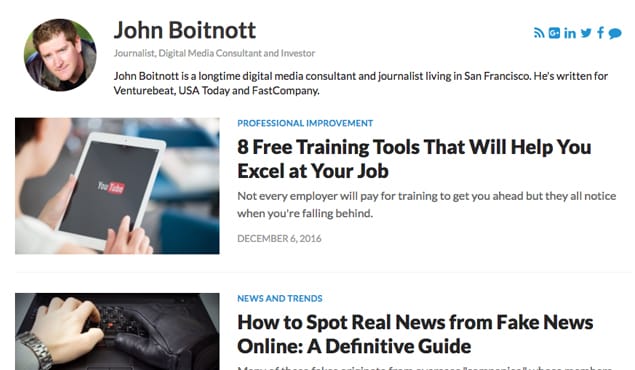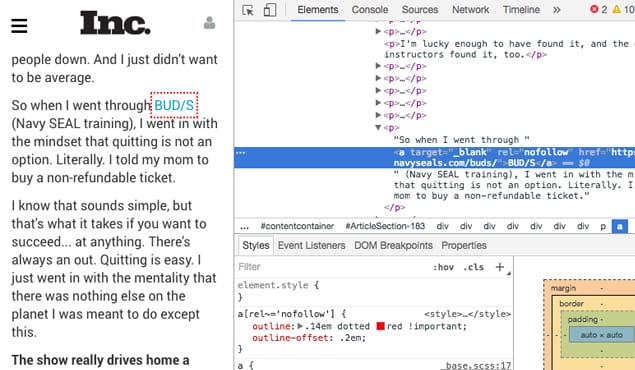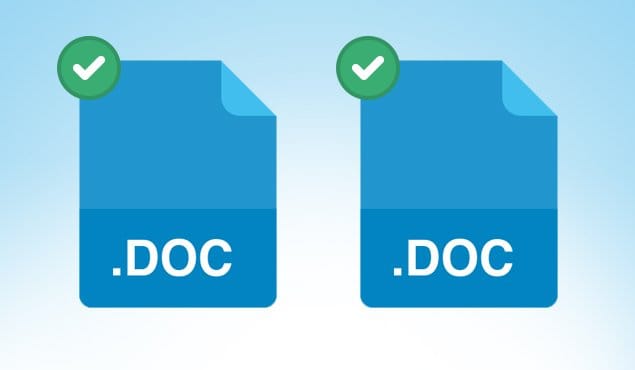For a long time, the primary driving force behind guest blogging was that ever-coveted link. Each time you wrote a post, you would cite a bunch of sources for your data, up to and including a link to your own website. This link would serve as an authoritative source of PageRank value, the so-called “link juice” that powers organic SEO. The more of these links you could build, the better off your site would be.
Then came the dark days of 2014. Almost three years ago, Matt Cutts, the then-head of Google’s webspam team, posted a fateful blog post to his personal blog. That post, titled “The decay and fall of guest blogging for SEO,” has earned an estimated 287,000 links (according to Majestic) in the last few years, as SEO bloggers and webmasters cite it to one another, doomsaying and arguing through the ages.
The general summary of the post is simple. Guest blogging with the sole goal of getting a link is no longer kosher. If the posts your blog publishes on other blogs are not relevant or valuable to that blog, your blog is liable to be penalized for it. To all webmasters who publish guest posts, Matt Cutts essentially said “nofollow it if you’re not certain.”
The reaction was immediate and the fallout has trickled down to today. The dust has settled, and the consensus is that guest posts are still valuable, but you should probably nofollow links whenever possible.
This is incorrect advice.
The real lesson you should be taking from this post and from the SEO developments that have followed, is that guest posts should be valuable. After all, from Google’s point of view, there’s very little difference between me guest posting on your blog and me being an irregular contributor to your blog. The only reason guest posts were called out is because of the unsolicited pitches webmasters would receive. They generally claimed they would write a good post for your site, and would perhaps even be willing to send you a product, a coupon, or a donation, and all they asked in return was a link.
The problem is the payment. The problem is the post generally lacked value. You would get something extremely generic, possibly poorly written or even copied, and you’d be paying for it with a link.
However, to be safe, many webmasters still make nofollow the default for links, either all links on their sites or just links they know come from their contributors in guest posts. So, without the value of a link, what do you get out of a guest post? Why does anyone still bother with it?
The Rise of Influencer Marketing
Influencer marketing is the concept that individual people have clout, and by associating with those people, you can gather up power of your own. If someone like Neil Patel, Rand Fishkin, or Barry Schwartz tweeted a link to your site, you would notice a sizable bump in traffic, conversions, and other beneficial metrics. That’s because these people are influential and the things they recommend tend to be things other people want to read. Those people trust their influencers to have good taste.
Influencer marketing is primarily centered around social media, but it works with blogs as well. Sites like the Huffington Post, VentureBeat, and Forbes are all large sites that funnel a lot of traffic to the destination links in their posts. They’re large sites that often nofollow their links, but that doesn’t matter. The links are still valuable.
Some large sites also strip links from guest posts, and add in their own if they feel they’re necessary. Even these are useful to your site, even without a link, and I’ll tell you why.
The Value of a Guest Post
Guest posting has a lot of potential sources of value. Let’s look them over.
First, you have the link itself. If the link is on a site that uses followed links, you’re golden. A link to your site from a relevant site will give you link juice. If the site isn’t very highly ranked, it might not be much, but there’s always value in a diverse link portfolio. Link juice from numerous sites is better than link juice from a few sites, even if a lot of those sites aren’t necessarily all that large. You can hook large sites whenever you can, and it will build upon the foundation you’ve created.
The link, when nofollowed, is still valuable. Links do have a purpose beyond link juice, after all. Remember how they’re one of the foundational elements of the internet? People click links. When a link is presented to them in an interesting enough context, they will click it and follow it to its destination. “Nofollow” doesn’t prevent users from clicking, just search engine spiders. So a link in a guest post still has the potential to send traffic to your website, and if the site you posted on is large enough, that bump in traffic can be significant.
Next, you have your byline. A byline will have your name and your brand name attached to it. This might not seem like much, but it’s how people become familiar with influencers online. If they see your name on your site all the time, sure, whatever, that’s expected. They might not even remember it. They’ll remember SiteName, but not necessarily Author Name from SiteName. Do you think of ProBlogger or of Darren Rowse?
When they see your face and your name on sites like Moz, Forbes, HuffPo, Search Engine Land, Search Engine Journal, and Hubspot, they’ll start to recognize you as an important person in the industry. Neil Patel is famous for a lot of reasons, but one of those is simply the fact that his name is everywhere. Other famous bloggers in the SEO industry contribute to a variety of sites, and as such their name becomes independent from their brand.
Make no mistake; this is what they want. By giving value to their name outside of the value of their brand, they wield immense power. If Neil Patel went out and started a new business, you can bet a lot of people are going to pay attention to it. He’ll start out with powerful links, press coverage, and support. He’ll find it easier to obtain funding from venture capitalists and investors. He’ll find it much easier to launch a new business just based on the value attached to his name.
This is value you can build through guest posting. Your name becomes recognized throughout your industry. It’s perhaps the fastest path to becoming an influencer available. Of course, you won’t be the next Neil Patel over night. It takes years to work up that much value, and it takes a highly successful business and a lot of influence from a brand as well. Still, you can become a low-level influencers, network with other low-level influencers to grow, and work your way up the chain.
Also, remember that a guest post is in some ways an endorsement. Even without a link, publishing your content on their site is their way of saying your content is valuable enough to be published on their site. It’s a recommendation that their readers check you out, even if it’s not explicitly stated as such. Getting these “endorsements” from top-tier sites can go a long way.
On top of all of that, you have the portfolio opportunity. Being published on a big name site is not just a source of direct value, it’s a bit of leverage you can use to get your foot in the door with other big name sites. You might not be able to write for Forbes right now, but once you publish on Huffington Post, on VentureBeat, on the New York Times or the Wall Street Journal, suddenly you’re not just some guy asking to post. You’re someone with credentials. That counts for a lot.
Finally, one more note about nofollowed links; they might still improve your SEO. It’s hard to say exactly, since they don’t pass ranking directly, but nofollow links are still read and parsed by Google. Noindex is the tag that makes them invisible. Nofollowed links can still count in your favor, because they’re a sign to Google that says “this brand is building links organically.” If they index all the links pointing at your site and don’t see any nofollowed links, they’re a lot more likely to assume you’re paying for value links, rather than building them naturally.
Making the Best Out of a Guest Post
So, with all of that value to be had, how can you harvest the most of it?
The first thing you want to do is do your research. Figure out what site you want a post to go on, and figure out what sort of topics they write about. Or, in other words, figure out what their readers like the most. This is the range of topics you’ll want to cover. You can’t just rehash something they already did, and you can’t do a basic version of a topic their audience knows very well. I wouldn’t be able to pitch a “basics of SEO” post to Moz, for example. You also need to tie it into your brand somehow, generally by making it focus on an aspect of the issue related to your brand. If I were to contribute a guest post to a site like Moz, with links to this site here, I would probably want to cover the topic of guest posting in some way.
Next, you need to write two posts. The first post will go on your site and should be published right around the time you start sending out your query and pitch for your guest post.
The idea is to use this post as a case study or as a hub of data. It’s the bait. This post will serve two purposes.
- It will show your target blog that you know about the subject they would be interested in and that you’ve written about it before.
- It will act as a destination for an in-context link you include in your post for your destination site. Editors usually will approve a link if it is to a useful piece of content, even if that content is on your own website.
The second post is, of course, the high-quality post you want to go on your destination site. It should include as much good information as you can pack into it, and links to expand on topics you don’t have space to cover in the post. Somewhere in that post should be a link to the first post, for a source and for added value. Sure, that link will end up nofollowed, but you’re doing it for the other sources of value.
Next, you need to figure out what your sales funnel is for the traffic coming in from your guest posts. You’re not linking to a landing page, which means your usual sales funnel simply doesn’t work. You need some other way of capturing those incoming users and pulling them into your web. Do you have a Hello Bar? Do you have pop-ins or pop-overs? Do you have a CTA in your content itself? If possible, make your on-site content angle towards a sales pitch without actually leaning full on. You don’t want to drive people away with overt marketing speech.
You should also have links to other ways an incoming user can benefit you. The fact is, most of them aren’t going to bother with converting right away. Most of them are there for the information, and have no interest or use for your product. You need to capture them in another way. You can do this through links to other valuable pieces of content, both through in-content links and through widget-based related post boxes.
Social sharing buttons are excellent here as well. Ideally, people will share your post when they arrive and find it valuable, and they will follow you because of that value. This all circles back into that cycle of exposure that helps you show up all over the web. The more recognized you are, the more of a reputation you can leverage to grow.
 ContentPowered.com
ContentPowered.com







